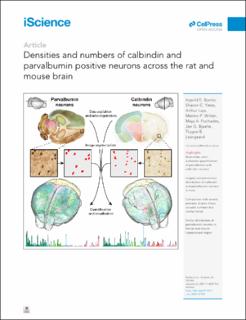| dc.contributor.author | Bjerke, Ingvild Elise | |
| dc.contributor.author | Yates, Sharon Christine | |
| dc.contributor.author | Laja, Arthur | |
| dc.contributor.author | Witter, Menno | |
| dc.contributor.author | Puchades, Maja | |
| dc.contributor.author | Bjaalie, Jan G. | |
| dc.contributor.author | Leergaard, Trygve B. | |
| dc.date.accessioned | 2021-01-22T11:04:44Z | |
| dc.date.available | 2021-01-22T11:04:44Z | |
| dc.date.created | 2021-01-10T14:54:06Z | |
| dc.date.issued | 2020 | |
| dc.identifier.citation | iScience. 2021, 24 (1), . | en_US |
| dc.identifier.issn | 2589-0042 | |
| dc.identifier.uri | https://hdl.handle.net/11250/2724250 | |
| dc.description.abstract | The calcium-binding proteins parvalbumin and calbindin are expressed in neuronal populations regulating brain networks involved in spatial navigation, memory processes, and social interactions. Information about the numbers of these neurons across brain regions is required to understand their functional roles but is scarcely available. Employing semi-automated image analysis, we performed brain-wide analysis of immunohistochemically stained parvalbumin and calbindin sections and show that these neurons distribute in complementary patterns across the mouse brain. Parvalbumin neurons dominate in areas related to sensorimotor processing and navigation, whereas calbindin neurons prevail in regions reflecting behavioral states. We also find that parvalbumin neurons distribute according to similar principles in the hippocampal region of the rat and mouse brain. We validated our results against manual counts and evaluated variability of results among researchers. Comparison of our results to previous reports showed that neuron numbers vary, whereas patterns of relative densities and numbers are consistent. | en_US |
| dc.language.iso | eng | en_US |
| dc.publisher | Elsevier | en_US |
| dc.rights | Navngivelse 4.0 Internasjonal | * |
| dc.rights.uri | http://creativecommons.org/licenses/by/4.0/deed.no | * |
| dc.title | Densities and numbers of calbindin andparvalbumin positive neurons across the rat and mouse brain | en_US |
| dc.type | Peer reviewed | en_US |
| dc.type | Journal article | en_US |
| dc.description.version | publishedVersion | en_US |
| dc.source.volume | 24 | en_US |
| dc.source.journal | iScience | en_US |
| dc.source.issue | 1 | en_US |
| dc.identifier.doi | http://dx.doi.org/10.1016/j.isci.2020.101906 | |
| dc.identifier.cristin | 1868327 | |
| dc.relation.project | Norges forskningsråd: 269774 | en_US |
| dc.relation.project | EC/H2020/945539 | en_US |
| dc.relation.project | Norges forskningsråd: 197467 | en_US |
| dc.relation.project | Norges forskningsråd: 295721 | en_US |
| dc.relation.project | Norges forskningsråd: 223262 | en_US |
| dc.relation.project | EC/H2020/785907 | en_US |
| dc.relation.project | Norges forskningsråd: 227769 | en_US |
| dc.description.localcode | This is an open access article distributed under the terms of the Creative Commons CC-BY license, which permits unrestricted use, distribution, and reproduction in any medium, provided the original work is properly cited. | en_US |
| cristin.ispublished | true | |
| cristin.fulltext | original | |
| cristin.qualitycode | 1 | |

